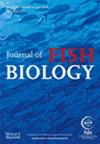比目鱼体密度与摄食习性的关系。
IF 2
3区 农林科学
Q2 FISHERIES
引用次数: 0
摘要
测定了16种比目鱼的体密度。它们的密度变化范围为1.011 ~ 1.074 g cm-3,其中底栖动物的密度最高,混合型次之,远洋型次之。格陵兰大比目鱼(Reinhardtius hippoglossoides)的能量最低(1.022±0.0052 g cm-3),低于海水密度(1.026 g cm-3),表明该物种能够以较低的能量消耗离开海底。以这种方式,低体密度可能有助于远洋捕食。进一步研究每种比目鱼的脂质含量和其他身体特征,有望更清楚地阐明它们的进化特征。本文章由计算机程序翻译,如有差异,请以英文原文为准。
Relationship between body density and feeding habit among flatfishes.
The body density of 16 species of flatfish was measured. Their density varied, ranging from 1.011 to 1.074 g cm-3, with benthic feeders tending to have the highest values, followed by mixed feeders and then pelagic feeders. Greenland halibut, Reinhardtius hippoglossoides, had the lowest value (1.022 ± 0.0052 g cm-3), below the density of seawater (1.026 g cm-3), indicating that this species can swim away from the sea floor with low-energy costs. In this manner, low body density may contribute to pelagic feeding. Further study of lipid content and other body characteristics of each flatfish is expected to elucidate their evolutionary traits more clearly.
求助全文
通过发布文献求助,成功后即可免费获取论文全文。
去求助
来源期刊

Journal of fish biology
生物-海洋与淡水生物学
CiteScore
4.00
自引率
10.00%
发文量
292
审稿时长
3 months
期刊介绍:
The Journal of Fish Biology is a leading international journal for scientists engaged in all aspects of fishes and fisheries research, both fresh water and marine. The journal publishes high-quality papers relevant to the central theme of fish biology and aims to bring together under one cover an overall picture of the research in progress and to provide international communication among researchers in many disciplines with a common interest in the biology of fish.
 求助内容:
求助内容: 应助结果提醒方式:
应助结果提醒方式:


